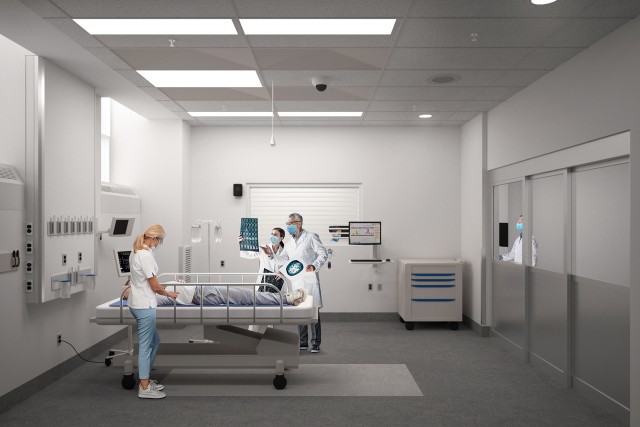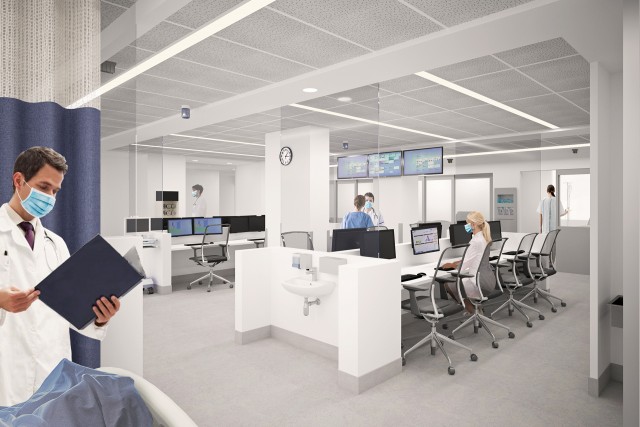Modernizing the Montreal General Hospital’s emergency department
In 2019, the McGill University Health Centre (MUHC) commissioned Jodoin Lamarre Pratte architectes to redevelop and modernize the Montreal General Hospital’s emergency department, which had significant operational shortcomings and deficiencies in patient monitoring and infection control.
Affiliated with the Faculty of Medicine and Health Sciences at McGill University, the Montreal General Hospital operates one of the busiest trauma centres in the province and the only one located in downtown Montréal.
Projet timeline
2019 — 2023

Redeveloping and expanding the trauma sector
To adequately modernize this critical department of the Montreal General Hospital, it was essential to expand and reconfigure the trauma sector. Three isolated trauma rooms were built, equipped with negative pressure ventilation systems to minimize the risk of infection. They were fitted with medical equipment and innovative technologies that facilitate communication between the inside and outside of the rooms. For example, sliding glass doors that can be made opaque when needed allow staff to better supervise patients from the medical support corridor. Previously, the trauma rooms and medical support area were separated by solid doors with only small glass openings, making it difficult for staff to share information without entering the room, thus increasing circulation and the risk of infection.
Each room is paired with a workstation in the support area that is equipped with three monitors, enabling staff to monitor a patient’s condition through audio, video, and vital signs without having to enter the room. Finally, recessed storage areas were created in the support corridor for clean supplies and mobile equipment, reducing clutter in the trauma rooms.
"The aim of the new standards was to limit the number of people coming and going into the rooms, to minimize the risk of infection. Also, the rooms are separated from each other. There are no more curtains, yet another way to increase infection control. We chose to install a sliding door with optional opaque glass, to be used in case of a delicate procedure."
Project Manager, CUSM

"Monitoring is the heart of the ED, and we now get to do our work in a wide-open, brighter space."
Nursing Professional Development Educator
Redeveloping the monitored stretcher area and the medical support area
The previous layouts of this critical area of the emergency department made it difficult for staff to work and provide patient care, even from centralized workstations. Spaces were dark and cluttered, and patient monitoring was limited due to poor visibility. In addition, only one area provided negative pressure isolation for infectious cases.
To rectify this situation, seven stretcher rooms were created in the vicinity of a bright, open medical support area. Designed to be completely isolated, the rooms are equipped with negative pressure ventilation systems, sliding doors, telecommunications systems for monitoring and calls, medical gas panels, and electrical services.
"It's great for morale. Patients come here with serious injuries or life-threatening conditions and there is often a lot of stress. We will be able to take care of them with even better equipment."
Director of Trauma at the Montreal General Hospital
The work was divided into phases to limit the impact on the department’s operations and maintain essential links with the different areas of the emergency unit.